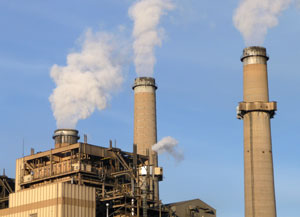 Lauren Sommer’s two-part radio series on carbon capture in California airs this week on The California Report. You can also view her slide show at the end of this post.
Lauren Sommer’s two-part radio series on carbon capture in California airs this week on The California Report. You can also view her slide show at the end of this post.
The idea seems simple enough: In order to get energy, we burn carbon. In most cases, that carbon comes out of the ground in the form of natural gas or coal. So instead of releasing the resulting carbon dioxide emissions into the atmosphere, why not put it back into the ground?
Of course, carbon capture and storage/sequestration (CCS) is much more complicated than that. Nonetheless it’s a strategy that’s being pursued aggressively by both international leaders and US Energy Secretary Steven Chu, who would like to see it deployed in ten years.
There are obstacles on both the “capture” and “storage” side of the equation. In terms of technology, however, “storage” is much further along, thanks to the oil and gas industry, which is already using CO2 in oil recovery. Injecting compressed CO2 into oil fields forces more oil to the surface in a process known as enhanced oil recovery. As many in the industry will remind you, they have three decades of experience doing this.
Keeping it underground is another matter. In the western US, the West Coast Regional Carbon Sequestration Partnership (WestCarb) is setting up a number of pilot projects to study how CO2 can be safely stored underground. As Technical Director Larry Myer explained to me, one of the primary goals is to simply work out the regulatory, siting, and liability issues.
As with any waste issue, choosing the site is the most important–and often most difficult–issue. California’s Central Valley has plenty of underground saline aquifers and depleted oil and gas fields that could hold CO2. But the trick is finding a site where the geology can securely store it and where there’s little risk of groundwater contamination. On the plus side, scientists know that CO2 is slowly immobilized underground, which lessens the risk over time. But how long that takes is still under study.
As for the “capture” issue, there are three ways to separate CO2 from power plant emissions.
- In today’s Climate Watch story, I describe Oxyfuel technology, in which natural gas is burned in pure oxygen. Since the outputs are steam and carbon dioxide, the CO2 can be easily siphoned off. But that requires building new power plants from scratch.
- The second option seeks to deal with the carbon dioxide before the fuel is burned; a “pre-combustion” approach. Or for all you wonks out there: Integrated Gasification Combined Cycle (IGCC). The downside to this process is that it requires gobs of energy, which makes it expensive.
- Finally, there’s the “post-combustion” approach. That’s where the CO2 is “scrubbed” from flue gas after the fuel is burned. Existing plants can be retrofitted with this technology, but it also comes with large energy penalty, just like IGCC.
A price on carbon, through either a cap-and-trade system or carbon tax, would change the economic case for CCS, but there are a lot of strikes against the technology. So why pursue it?
The argument goes like this: In order to achieve steep emissions cuts–say an 80% reduction worldwide by 2050–it may be an important tool (or stabilization wedge). The world will continue to use fossil fuels in the near term and despite the enormous growth of renewable energy, it’s still a drop in the bucket. That’s why many believe that CCS is a crutch the world needs to wean ourselves from fossil fuels.
